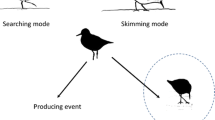Summary
I studied the foraging behavior of ruddy ducks (Oxyura jamaicensis) feeding on patchily distributed prey in a large (5-m long, 2-m wide, and up to 2-m deep) aquarium. The substrate consisted of a 4x4 array of wooden trays (1.0-m long, 0.5-m wide, and 0.1-m deep) which contained 6 cm of sand. Any tray could be removed from the aquarium and “loaded” with a known number of prey. One bird foraged in the aquarium at a time; thus, by removing a food tray after a trial ended and counting the remaining prey, I calculated the number of prey consumed by the bird. I designed several experiments to determine if ruddy ducks abandoned a food patch in a manner consistent with the predictions of a simple, deterministic, patch depletion model. This model is based on the premise that a predator should maximize its rate of net energy intake while foraging. To accomplish this, a predator should only remain in a food patch as long as its rate of energy intake from that patch exceeds the average rate of intake from the environment. In the majority of comparisons, the number of food items consumed by the ruddy ducks in these experiments was consistent with the predictions of the foraging model. When the birds did not forage as predicted by the model, they stayed in the patch longer and consumed more prey than predicted by the model. An examination of the relation between rate of net energy intake and time spent foraging in the food patch indicated that by staying in a patch longer than predicted, the ruddy ducks experienced only a small deviation from maximum rate of net energy intake. These results provided quantitative support for the prediction that ruddy ducks maximize their rate of net energy intake while foraging.
Similar content being viewed by others
References
Belovsky GE (1981) Food plant selection by a generalist herbivore: the moose. Ecol 62:1020–1030
Belovsky GE (1984) Summer diet optimization by beaver. Am Midl Nat 111:209–221
Brody S (1945) Bioenergetics and growth. Reinhold, New York
Charnov EL (1976) Optimal foraging: the marginal value theorem. Theor Pop Biol 9:129–136
Charnov EL, Orians GH, Hyatt K (1976) Ecological implications of resource depression. Am Nat 110:247–259
Cowie RJ (1977) Optimal foraging in great tits (Parus major). Nature 268:137–139
Efron B, Gong G (1983) A leisurely look at the boostrap, the jackknife, and cross-validation. Am Stat 37:36–48
Emlen JM (1966) The role of time and energy in food preference. Am Nat 100:611–617
Green RF (1980) Bayesian birds: a simple example of Oaten's stochastic model of optimal foraging. Theor Pop Biol 18:244–256
Green RF (1984) Stopping rules for optimal foragers Am Nat 123:30–40
Iwasa Y, Higashi M, Yanamura N (1981) Prey distribution as a factor determining the choice of optimal foraging strategy. Am Nat 117:710–723
Janetos AC, Cole BJ (1981) Imperfectly optimal animals. Behav Ecol Sociobiol 9:203–209
Kamil AC (1983) Optimal foraging and the psychology of learning. Am Zool 23:291–302
Krebs JR (1978) Optimal foraging: decision rules for predators. In: Krebs JR, Davies NB (eds) Behavioural ecology: an evolutionary approach. Blackwell, Oxford, England, pp 23–63
Krebs JR, Cowie RJ (1976) Foraging strategies in birds. Ardea 64:98–116
Krebs JR, Ryan JC, Charnov EL (1974) Hunting by expectation or optimal foraging? A study of patch use by chickadees. Anim Behav 22:953–964
Krebs JR, Erichsen JT, Webber MI, Charnov EL (1977) Optimal prey selection in the great tit (Parus major). Anim Behav 25:30–38
Krebs JR, Stephans DW, Sutherland WJ (1983) Perspectives in optimal foraging. In: Brush AH, Clark GA (s) Perspectives in ornithology. Cambridge Univ Press, Cambridge, pp 163–216
MacArthur RH, Pianka ER (1966) On optimal use of a patchy environment. Am Nat 100:603–609
McNair JN (1982) Optimal giving-up times and the marginal value theorem. Am Nat 119:511–529
McNair JN (1983) A class of patch-use strategies. Am Zool 23:303–313
McNamara J (1982) Optimal patch use in a stochastic environment. Theor Pop Biol 21:269–288
Oaten A (1977) Optimal foraging in patches: a case for stochasticity. Theor Pop Biol 12:263–285
Pyke GH (1984) Optimal foraging theory: a critical review. Ann Rev Ecol Syst 15:523–575
Pyke GH, Pulliam HR, Charnov EL (1977) Optimal foraging: a selective review of theory and tests. Q Rev Biol 52:137–154
Siegfried WR (1973) Summer food and feeding of the ruddy duck in Manitoba. Can J Zool 51:1293–1297
Sih A (1982) Optimal patch use: variation in selective pressure for efficient foraging. Am Nat 120:666–685
Smith JNM, Dawkins R (1971) The hunting behavior of individual great tits in relation to spatial variations in their food density. Anim Behav 19:695–706
Smith JNM, Sweatman HPA (1974) Food-searching behavior of titmice in patchy environments. Ecology 55:1216–1232
Stephans DW, Charnov EL (1982) Optimal foraging: some simple stochastic models. Behav Ecol Sociobiol 10:251–263
Tome MW (1981) Reproductive bioenergetics of female ruddy ducks in Manitoba. MS thesis University of Maine
Tome MW (1984) Changes in nutrient reserves and organ size of female ruddy ducks breeding in Manitoba. Auk 101:830–837
Tome MW (1986) Foraging behavior of ruddy ducks: a test of optimal foraging theory. Ph D dissertation. University of Michigan
Ward, P, Batt, BDJ (1973) Propagation of captive waterfowl: the Delta Waterfowl Research Station system. Wildl Mgmt Inst, Washington DC
Woakes AJ, Butler PJ (1983) Swimming and diving in tufted ducks, Aythya fuligula, with particular reference to heart rate and gas exchange. J Exp Biol 107:311–329
Wooley JB, Owen RB Jr (1978) Energy costs of activity and daily energy expenditure in the black duck. J Wildl Manage 42:739–745
Zar JH (1974) Biostatistical analysis. Prentice-Hall Inc Englewood Cliffs NJ
Author information
Authors and Affiliations
Rights and permissions
About this article
Cite this article
Tome, M.W. Optimal foraging: food patch depletion by ruddy ducks. Oecologia 76, 27–36 (1988). https://doi.org/10.1007/BF00379596
Received:
Issue Date:
DOI: https://doi.org/10.1007/BF00379596




